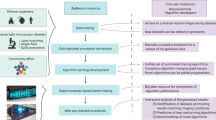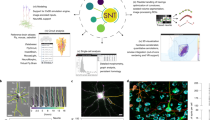Abstract
Neuroanatomic analysis depends on the reconstruction of complete cell shapes. High-throughput reconstruction of neural circuits, or connectomics, using volume electron microscopy requires dense staining of all cells, which leads even experts to make annotation errors. Currently, reconstruction speed rather than acquisition speed limits the determination of neural wiring diagrams. We developed a method for fast and reliable reconstruction of densely labeled data sets. Our approach, based on manually skeletonizing each neurite redundantly (multiple times) with a visualization-annotation software tool called KNOSSOS, is ∼50-fold faster than volume labeling. Errors are detected and eliminated by a redundant-skeleton consensus procedure (RESCOP), which uses a statistical model of how true neurite connectivity is transformed into annotation decisions. RESCOP also estimates the reliability of consensus skeletons. Focused reannotation of difficult locations promises a rather steep increase of reliability as a function of the average skeleton redundancy and thus the nearly error-free analysis of large neuroanatomical datasets.
This is a preview of subscription content, access via your institution
Access options
Subscribe to this journal
Receive 12 print issues and online access
$209.00 per year
only $17.42 per issue
Buy this article
- Purchase on Springer Link
- Instant access to full article PDF
Prices may be subject to local taxes which are calculated during checkout






Similar content being viewed by others
References
Ramón y Cajal, S. Textura del Sistema Nervioso del Hombre y de los Vertebrados (Moya, Madrid, 1899).
Golgi, C. Sulla struttura della sostanza grigia del cervelo. Gazzetta Medica Italiana Lombardia 33, 244–246 (1873).
Harris, K.M. & Stevens, J.K. Dendritic spines of CA 1 pyramidal cells in the rat hippocampus: serial electron microscopy with reference to their biophysical characteristics. J. Neurosci. 9, 2982–2997 (1989).
Horikawa, K. & Armstrong, W.E. A versatile means of intracellular labeling: injection of biocytin and its detection with avidin conjugates. J. Neurosci. Methods 25, 1–11 (1988).
Stretton, A.O. & Kravitz, E.A. Neuronal geometry: determination with a technique of intracellular dye injection. Science 162, 132–134 (1968).
Wickersham, I.R. et al. Monosynaptic restriction of transsynaptic tracing from single, genetically targeted neurons. Neuron 53, 639–647 (2007).
Livet, J. et al. Transgenic strategies for combinatorial expression of fluorescent proteins in the nervous system. Nature 450, 56–62 (2007).
Sporns, O., Tononi, G. & Kotter, R. The human connectome: A structural description of the human brain. PLoS Comput. Biol. 1, e42 (2005).
Lichtman, J.W., Livet, J. & Sanes, J.R. A technicolour approach to the connectome. Nat. Rev. Neurosci. 9, 417–422 (2008).
Helmstaedter, M., Briggman, K.L. & Denk, W. 3D structural imaging of the brain with photons and electrons. Curr. Opin. Neurobiol. 18, 633–641 (2008).
White, J.G., Southgate, E., Thomson, J.N. & Brenner, S. The structure of the nervous system of the nematode Caenorhabditis elegans. Phil. Trans. R. Soc. Lond. B 314, 1–340 (1986).
Denk, W. & Horstmann, H. Serial block-face scanning electron microscopy to reconstruct three-dimensional tissue nanostructure. PLoS Biol. 2, e329 (2004).
Hayworth, K.J., Kasthuri, N., Schalek, R. & Lichtman, J.W. Automating the collection of ultrathin serial sections for large volume TEM reconstructions. Microsc. Microanal. 12, 86–87 (2006).
Knott, G., Marchman, H., Wall, D. & Lich, B. Serial section scanning electron microscopy of adult brain tissue using focused ion beam milling. J. Neurosci. 28, 2959–2964 (2008).
Briggman, K.L. & Denk, W. Towards neural circuit reconstruction with volume electron microscopy techniques. Curr. Opin. Neurobiol. 16, 562–570 (2006).
Briggman, K.L., Helmstaedter, M. & Denk, W. Wiring specificity in the direction-selectivity circuit of the retina. Nature (in the press) (2011).
Fiala, J.C. Reconstruct: a free editor for serial section microscopy. J. Microsc. 218, 52–61 (2005).
Jeong, W.K. et al. Ssecrett and NeuroTrace: interactive visualization and analysis tools for large-scale neuroscience data sets. IEEE Comput. Graph. Appl. 30, 58–70 (2010).
Trachtenberg, J.T. et al. Long-term in vivo imaging of experience-dependent synaptic plasticity in adult cortex. Nature 420, 788–794 (2002).
Stevens, J.K., McGuire, B.A. & Sterling, P. Toward a functional architecture of the retina: serial reconstruction of adjacent ganglion cells. Science 207, 317–319 (1980).
Chen, B.L., Hall, D.H. & Chklovskii, D.B. Wiring optimization can relate neuronal structure and function. Proc. Natl. Acad. Sci. USA 103, 4723–4728 (2006).
Chklovskii, D.B., Vitaladevuni, S. & Scheffer, L.K. Semi-automated reconstruction of neural circuits using electron microscopy. Curr. Opin. Neurobiol. 20, 667–675 (2010).
Mishchenko, Y. et al. Ultrastructural analysis of hippocampal neuropil from the connectomics perspective. Neuron 67, 1009–1020 (2010).
Jain, V. et al. Supervised learning of image restoration with convolutional networks. IEEE 11th Int. Conf. Comput. Vis. 1–8 (2007).
Andres, B., Köthe, U., Helmstaedter, M., Denk, W. & Hamprecht, F. Segmentation of SBFSEM volume data of neural tissue by hierarchical classification. in Pattern Recognition: Lecture Notes in Computer Science (ed. Rigoll, G.) 142–152 (Springer-Verlag, 2008).
Turaga, S.C. et al. Convolutional networks can learn to generate affinity graphs for image segmentation. Neural Comput. 22, 511–538 (2010).
Martin, D., Fowlkes, C., Tal, D. & Malik, J. A Database of human segmented natural images and its application to evaluating segmentation algorithms and measuring ecological statistics. IEEE 8th Int. Conf. Comput. Vis. 2, 416–423 (2001).
Warfield, S.K., Zou, K.H. & Wells, W.M. Validation of image segmentation by estimating rater bias and variance. Philos. Transact. A Math. Phys. Eng. Sci. 366, 2361–2375 (2008).
Warfield, S.K., Zou, K.H. & Wells, W.M. Simultaneous truth and performance level estimation (STAPLE): an algorithm for the validation of image segmentation. IEEE Trans. Med. Imaging 23, 903–921 (2004).
Wang, W. et al. A classifier ensemble based on performance level estimation. IEEE Int. Symposium on Biomed. Imaging: from Nano to Micro, 342–345 (2009).
Körding, K. Decision theory: what “should” the nervous system do? Science 318, 606–610 (2007).
Crook, S., Gleeson, P., Howell, F., Svitak, J. & Silver, R.A. MorphML: level 1 of the NeuroML standards for neuronal morphology data and model specification. Neuroinformatics 5, 96–104 (2007).
Acknowledgements
We thank B. Andres, F. Hamprecht, U. Köthe, V. Jain, S. Seung and S. Turaga for many fruitful discussions and comments on the manuscript, J. Bollmann and A. Schaefer for helpful comments on the manuscript, C. Roome for information technology support, J. Kornfeld and F. Svara for programming KNOSSOS, and J. Hanne, H. Jakobi and H. Wissler for help with annotator training. We thank N. Abazova, E. Abs, A. Antunes, P. Bastians, J. Bauer, M. Beez, M. Beining, S. Bender, S. Best, L. Brosi, M. Bucher, E. Buckler, J. Buhmann, C. Burkhardt, F. Drawitsch, L. Ehm, S. Ehm, C. Fianke, R. Foltin, S. Freiss, M. Funk, A. Gebhardt, M. Gruen, K. Haase, J. Hammerich, J. Hanne, B. Hauber, M. Hensen, L. Hofmann, P. Hofmann, M. Hülser, F. Isensee, H. Jakobi, M. Jonczyk, A. Joschko, A. Juenger, S. Kaspar, K. Kessler, A. Khan, M. Kiapes, A. Klein, C. Klein, S. Laiouar, T. Lang, L. Lebelt, H. Lesch, C. Lieven, D. Luft, E. Moeller, A. Muellner, M. Mueller, D. Ollech, A. Oppold, T. Otolski, S. Oumohand, S. Pfarr, M. Pohrath, A. Poos, S. Putzke, J. Reinhardt, A. Rommerskirchen, M. Roth, J. Sambel, K. Schramm, C. Sellmann, J. Sieber, I. Sonntag, M. Stahlberg, T. Stratmann, J. Trendel, F. Trogisch, M. Uhrig, A. Vogel, J. Volz, C. Weber, P. Weber, K. Weiss, L. Weisshaar, E. Wiegand, T. Wiegand, M. Wiese, R. Wiggers, C. Willburger and A. Zegarra for neurite skeletonizations. This work was funded by the Max Planck Society.
Author information
Authors and Affiliations
Contributions
M.H. and W.D. designed the study and devised the analysis algorithms; K.L.B. carried out the SBEM experiments; M.H., K.L.B. and W.D. specified the KNOSSOS software; M.H. analyzed the data; M.H., K.L.B. and W.D. wrote the paper.
Corresponding author
Ethics declarations
Competing interests
Moritz Helmstaedter and Winfried Denk have applied for a patent (Published Patent Application US 20100183217). Winfried Denk receives IP license income from Gatan Inc. for serial blockface imaging.
Supplementary information
Supplementary Text and Figures
Supplementary Figures 1–5 (PDF 576 kb)
Supplementary Movie 1
Skeleton tracing with KNOSSOS. 3 orthogonal views are displayed (xy, top left, yz, top right, xz, bottom left) and a 3-dimensional view of the dataset bounding box and the skeleton being created (bottom right). The 19MB version requires a video player compatible with DivX-encoded files. The 68MB version can be viewed with a generic player but is shorter. (ZIP 51786 kb)
Rights and permissions
About this article
Cite this article
Helmstaedter, M., Briggman, K. & Denk, W. High-accuracy neurite reconstruction for high-throughput neuroanatomy. Nat Neurosci 14, 1081–1088 (2011). https://doi.org/10.1038/nn.2868
Received:
Accepted:
Published:
Issue Date:
DOI: https://doi.org/10.1038/nn.2868
This article is cited by
-
RoboEM: automated 3D flight tracing for synaptic-resolution connectomics
Nature Methods (2024)
-
Online conversion of reconstructed neural morphologies into standardized SWC format
Nature Communications (2023)
-
Seg2Link: an efficient and versatile solution for semi-automatic cell segmentation in 3D image stacks
Scientific Reports (2023)
-
Volume electron microscopy
Nature Reviews Methods Primers (2022)
-
Automated synapse-level reconstruction of neural circuits in the larval zebrafish brain
Nature Methods (2022)



